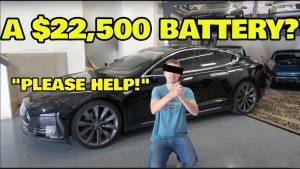Why Buy a Tesla When You Can Rent One? - EPautos - Libertarian Car Talk

Tesla is having trouble selling vehicles. It is the same problem besetting every company trying to sell battery-powered vehicles, because Tesla pretty much saturated whatever “market” for them there was for them. There is even less of a “market” for Tesla imitators from Ford, Mercedes, GM and all the rest who thought one could be manufactured by the government.
Now Tesla is resorting to renting the battery powered cars it cannot sell.
“With inventories piling up at stores and dealers across the country, Tesla has found a new way to use its inventory: it is now renting (not leasing) its vehicles from its stores,” says Elektrec – which is a site that covers the battery-powered “market.” 
You can rent a Tesla for up to a week starting at $60 per day. The idea seems to be to sell the hesitant on the wonders of battery powered vehicles. Tesla – the company – dangles a $250 credit if the renter turns into a buyer. But $250 isn’t much of an inducement to buy into owning a battery powered vehicle. There is a saying – slightly coarse – that if it Flies Floats or Fucks – you’re better off renting. This saying is especially applicable to battery powered vehicles on account of their horrendous depreciation – about 30 percent worse on average than what you’d lose over five years after buying a vehicle that isn’t battery powered.
The reason why being the battery.
It loses value even faster than charge – because of the loss of charge capacity. Even the optimists concede a 10 percent loss in charge capacity over ten years, something that would be cause for recalls and lawsuits were we talking about a vehicle with a gas tank. The EPA would go berserk, too – because a 10 percent loss amounts to a significant increase in “emissions,” doesn’t it – since the vehicle is now less efficient. It consumes more power – electricity, in this case – and electricity must be generated and that will likely mean generating more C02.
But EVs have gotten a pass so far. Just like Dr. Fauci. 
The inevitable waning of charge capacity is also much worse than it would be if we were talking about a vehicle with a leaking gas tank because it is worth replacing a leaking gas tank. Maybe $1,000 in parts and labor – because a gas tank is (typically, in most new vehicles) just a formed plastic container – and plastic is just about the only thing that’s still inexpensive. It is also relatively easy to remove a leaking gas tank. It does not require taking the body off the chassis – as is necessary to get at/remove a battery powered vehicle’s battery.
But it is the disproportionate cost of replacing a dying battery – relative to the value of the vehicle, itself – that makes replacing it not worth the cost and it is this now-well-known problem that accounts for the harrowing depreciation that you buy into when you buy a battery-powered vehicle.
And who – with knowledge – would buy into that?
Apologists try to dance around this. They say that if you are careful about how you charge – and mindful of the extent to which you keep the thing charged – you can keep the loss of charge capacity to a minimum for ten years or even longer. They do not talk about the fact that it is inevitable, regardless.
This is another variant of “safe and effective.”
First, you’re supposed to avoid fully charging the battery. Yes, really. The battery’s “health” is optimized by keeping it partially charged. But then you only have so much range; i.e., not very much. This puts you in the position of needing a charge sooner – and (unless you have hours to wait) you will probably want it faster. That means driving to a public/commercial “fast” charger, where very high voltage AC current can be drawn into the battery relatively quickly. But if you do this regularly, you risk compromising the ‘health” of the battery – because “fast” charging is hard on the battery.
You also increase the risk of a fire, which isn’t very healthy, either.
This is why “fast” charging is limited to 80 percent of the battery’s maximum charge capacity. It’s like leaving a gas station with a tank that’s already 20 percent low – only with a much longer wait to get to 80 percent full.
Consider the conundrum.
If you want to use a battery-powered vehicle to the fullest extent of its advertised capabilities – i.e., you’d like to drive the full however-many-miles of range the thing’s manufacturer says it can be driven before you must stop and wait for a charge – then you will need to fully charge the battery first. But fully charging negatively affects the battery’s “health.
So you try to keep it partially charged. 
Which means more frequent stopping – and waiting – for a partial charge.
You try to cur down on the time you have to wait by using “fast” chargers but that’s not good for the battery’s “health,” either – so you try to do your charging at home, where at least you can spend the time doing something else besides waiting at a Sheetz watching the traffic come and go.
The comes winter – and you lose charge even faster, especially if you use the heater.
It sounds like a lot of fun, doesn’t it?
“Tesla appears to be using this to show potential buyers how convenient it is to own a Tesla vehicle,” says Elektrec. The device-peddler “also includes Supercharging and Full Self-Driving (Supervised) for free with every rental.”
We’ll see how many take it. And if they don’t, Tesla’s left with – essentially – used cars to try to sell. Miles on them, probably stains on the seats and paint scratches, too. That can be cleaned up, but a car with more than a handful of miles on it isn’t new anymore. Maybe it’s a good thing these things ought not to be driven very far.
Even so, Tesla is likely going to end up with an inventory of used rental cars that are also battery powered devices that are the four-wheeled equivalents of the “vaccines” that Pfizer, et al continue to peddle.
Good luck selling that.
. . .
If you like what you’ve found here please consider supporting EPautos.
We depend on you to keep the wheels turning!
Our donate button is here.
If you prefer not to use PayPal, our mailing address is:
EPautos
721 Hummingbird Lane SE
Copper Hill, VA 24079
PS: Get an EPautos magnet or sticker or coaster in return for a $25 or more one-time donation or a $10 or more monthly recurring donation. (Please be sure to tell us you want a magnet or sticker or coaster – and also, provide an address, so we know where to mail the thing!)
If you’d like a Baaaaa hat or other EPautos gear, see here!


